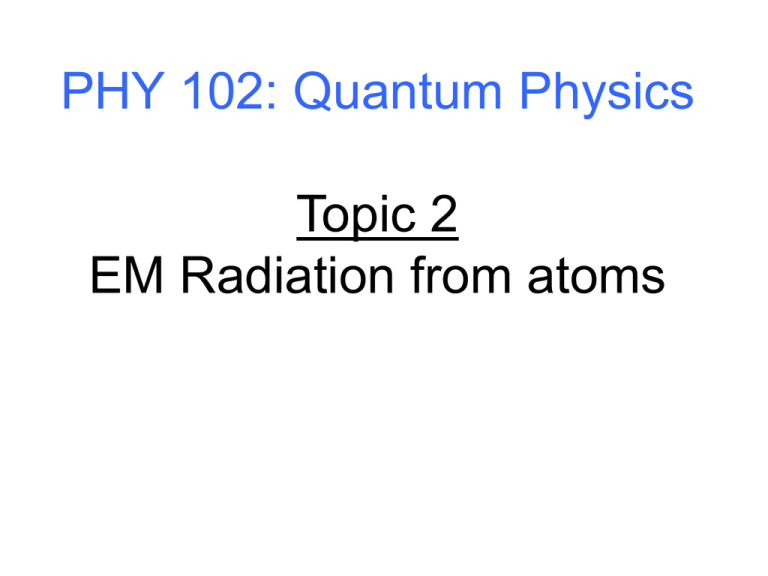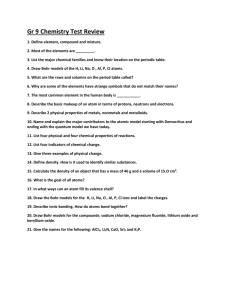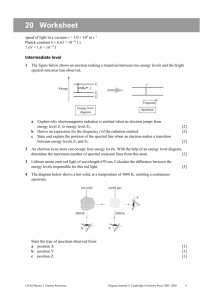PHY 102: Quantum Physics Topic 2 EM Radiation from atoms
advertisement

PHY 102: Quantum Physics Topic 2 EM Radiation from atoms •Broadband Thermal Radiation •“Blackbody” spectrum •Resolution of “ultraviolet catastrophe” •Atomic line spectra •Structure of the atom: Rutherford scattering Thermal Radiation •Heat is associated with vibrational thermal motion of atoms/molecules •General principle: accelerating charged particles generate electromagnetic radiation (examples: generation of radio waves by moving electrons in antenna, generation of continuous X-ray spectrum by electrons decelerated by interaction with atoms of metal target) •So, e.m. radiation is generated by the thermally induced motion of atoms/molecules: THERMAL RADIATION…. Thermal Radiation •Unlike convection and conduction, transfer of heat by thermal radiation doesn’t require a “medium” •So, for example, heat can reach Earth from the Sun through millions of kilometres of empty space. •Rate at which an object, surface area A, temperature T, radiates energy is given by Stefan’s Law P AeT 4 = “Stefan’s constant” = 5.67 x 10-8 Wm-2K-4 e = “emissivity” ; 0< e < 1, depending on nature of surface For a “black body” (perfect emitter/absorber), e=1 Spectrum of emitted radiation Black body emission spectrum for various temperatures •Peak wavelength decreases with increasing temperature •Area under curve (total emitted power increases with increasing temperature •Experimentally, the dependence of peak wavelength on temperature is found to be given by: (m) pT constant 2.90 103 m.K “Wien’s displacement law” Modelling the black body spectrum •Rayleigh attempted to calculate the black body spectra from solids by assuming the radiation to originate from classical EM standing waves (“normal modes”) within the object •Standing wavelength in one dimension for cubic box of side L: 2L n •wavenumber: •n = 1,2,3,……………….. 2 n k L Modelling the black body spectrum •Rayleigh attempted to calculate the black body spectra from solids by assuming the radiation to originate from classical EM standing waves (“normal modes”) within the object •Standing wavelength in one dimension for cubic box of side L: 2L n •wavenumber: •n = 1,2,3,……………….. 2 n k L Modelling the black body spectrum •In 3 dimensions, ktotal given by: ktotal2 k x2 k y2 k z2 •for cube of side L: n1 n 2 n 3 kx ;k y ;k z L L L •In “k-space” each allowed state occupies a “volume” 3/L3 “k-space” How much energy is emitted? • energy emitted in a wavenumber range between k and k + dk, Number of modes in wavenumber range x energy per mode Number of modes “Volume” of spherical shell between k and k + dk? “Volume” occupied by each mode in k-space? 4 k 2 dk Vk 2 dN(k) 2 2 dk 3 8 3 L Factor of 2 for two different independent polarizations per mode, V=L3 Energy per mode? According to classical equipartition theory, each mode (classical oscillator) has energy E = kbT So……………. dE(k) 2 Vk kb T 2 dk Changing variables to wavelength: dE(k) 2 Vk kb T 2 dk Vk 2 kb T dk V 4 2 kb T 2 dE( ) d 2 d 2 2 2 d 8Vk b T 4 dE( ) 8Vkb T d 4 d Spectral Intensity (Rayleigh prediction) • Defined as radiated power per unit wavelength volume per unit area per unit time: 1 dE( ) I( ) c geometrical factors V d • Rayleigh-Jeans result: I( ) 2ckT 4 Spectrum of emitted radiation Black body emission spectrum for various temperatures •Peak wavelength decreases with increasing temperature •Area under curve (total emitted power increases with increasing temperature •Experimentally, the dependence of peak wavelength on temperature is found to be given by: (m) pT constant 2.90 103 m.K “Wien’s displacement law” “ULTRAVIOLET CATASTROPHE”……………. Rayleigh classical theory doesn’t work. Classical vs Quantum Classical (Rayleigh-Jeans) picture: •EM modes have continuous spread of energies •Average energy of oscillator at temperature T = kT Quantum (Planck) picture: •EM modes only allowed to have energy in integer multiples of some constant times the oscillator frequency: E = nhf •Average energy of oscillator at temperature T: hf E hf e kT 1 Modelling the black body spectrum Obtain expression for spectral intensity by taking product of average energy per oscillator and number of oscillator modes per unit volume……. Planck result: 2hc 2 I ( ) 5 hc kT e 1 •This model predicts the form of the blackbody spectrum perfectly, no “UV catastrophe” •First experimental “anomaly” to be explained by the need for a quantum theory (1900) •“h” originally introduced by Planck purely as an empirical constant to fit data………………………… 2hc I( ) 5 hc kT e 1 2 2.50E+10 1.50E+10 1.00E+10 5.00E+09 9.8 9.2 8.6 8 7.4 6.8 6.2 5 5.6 4.4 3.8 3.2 2.6 2 1.4 0.8 0.00E+00 0.2 I(W/m3) 2.00E+10 Wavelength/m Quantum theory gives excellent agreement with experiment. Line spectra •“Hot” solids and liquids display the continuous emission spectra described above •“excited” gases display something completely different: LINE SPECTRA Line spectra •Line spectrum of a gas of atoms/molecules is reproducible, and is a unique “fingerprint” of the gas •Suggests that the spectrum is somehow related to the internal structure of the atom………. •So, what is an atom??? The atom: a brief (incomplete) history Leucippus of Miletus, Democritus (~450BC) Suggest universe composed of hard, uniform, indivisible particles and the space between them (“atom” ≈ “cannot be cut”) Pierre Gassendi (1592-1655), Robert Boyle (1627-1691) Matter composed of rigid, indestructible atoms, varied size and form, different elements composed of different atoms, atoms can combine to form molecules………. Joseph Louis Proust (1754-1826), John Dalton (1766-1844) “Law of definite proportions”, atomic picture of chemical processes, stoichiometry Lothar Meyer (1830-95), Dmitry Mendeleev (1834-1907) Significance of atomic weights, Periodic Table of the elements The atom: a brief (incomplete) history So, by the 19th century, it was universally accepted that matter was composed of atoms. But we still haven’t answered the question. What is an atom? 1897: JJ Thomson discovers electron, measures ratio e/m 1907: Millikan measures charge on electron ~1910: Thomson’s “plum pudding” model of the atom 1910-1911: Rutherford, Geiger and Marsden clarify internal structure of atom by scattering of positively charged -particles………….. Rutherford Scattering Most particles pass straight through, or deflected only slightly Some particles deflected back through large angles Rutherford Scattering To explain results of the Rutherford scattering : 1) Atom must be mostly empty space 2) Positive charge must be concentrated in a small volume occupying a very small fraction of the total volume of the atom………… Christmas pudding model doesn’t work Nuclear model does work Atomic radius ~ 10-10m Nuclear radius ~ 10-14m The Rutherford/Bohr Model •More on line spectra •Orbital model of the hydrogen atom •Failure of classical model •Quantisation of orbital angular momentum: stationary states •Successes and failures of the Bohr Model Line Spectrum of hydrogen •Hydrogen has line spectrum ranging in wavelength from the UV to the infrared •Balmer (1885) found that the wavelengths of the spectral lines in the visible region of the spectrum could be EMPIRICALLY fitted to the relationship: m2 (nm) 364.6 2 : m 3, 4, 5......... m 4 (The group of hydrogen spectral lines in the visible region still known as the Balmer Series) Line Spectrum of hydrogen •Rydberg and Ritz subsequently obtained a more general expression which applies to ALL hydrogen spectral lines (not just visible), and also to certain elements (eg alkaline metals): 1 1 R 2 2 n2 n1 1 n2, n1 integers, n2 < n1 •R is called the Rydberg constant, which changes slightly from element to element. •For hydrogen, RH = 1.097776 x 107 m-1 •Can a model of the atom be developed that’s consistent with this nice, elegant formula?? Rutherford Scattering To explain results of the Rutherford scattering : 1) Atom must be mostly empty space 2) Positive charge must be concentrated in a small volume occupying a very small fraction of the total volume of the atom………… Christmas pudding model doesn’t work Nuclear model does work Atomic radius ~ 10-10m Nuclear radius ~ 10-14m Rutherford “planetary” model Basic idea: electrons in an atom orbit the positively-charged nucleus, in a similar way to planets orbiting the Sun (but centripetal force provided by electrostatic attraction rather that gravitation) Hydrogen atom: single electron orbiting positive nucleus of charge +Ze, where Z =1: v r -e +Ze F Rutherford Model: electron energy v r -e +Ze F From electrostatics, the potential energy of the electron is given by: q1q2 ( Ze) (e) Ze 2 U 40 r 40 r 40 r Rutherford Model: electron energy v r -e +Ze F Centripetal force equation: me v 2 Ze 2 r 40 r 2 Kinetic energy of electron: me v 2 Ze 2 2 80 r Total energy of electron = P.E. + K.E: q1q2 ( Ze) (e) Ze 2 U 40 r 40 r 40 r me v 2 Ze 2 2 80 r Ze 2 Ze 2 Ze 2 Total energy 40 r 80 r 80 r But this classical treatment leaves us with a big problem……… Failure of the Classical model The orbiting electron is an accelerating charge. Accelerating charges emit electromagnetic waves and therefore lose energy Classical physics predicts electron should “spiral in” to the nucleus emitting continuous spectrum of radiation as the atom “collapses” CLASSICAL PHYSICS CAN’T GIVE US STABLE ATOMS……………….. Bohr’s postulates • Only certain electron orbits are allowed, in which the electron does not emit em radiation (STATIONARY STATES) •An atom emits radiation only when an electron makes a transition from one stationary state to another. •The frequency of the radiation emitted when an electron makes a transition from a stationary state with energy E2 to one with energy E1 is given by: E2 E1 f h Transition energies Suppose an electron is initially in stationary state with energy E1, orbital radius r1. It then undergoes a transition to a lower energy state E2, with (smaller) radius r2: Ze 2 Ze 2 Ze 2 1 1 E1 E2 80 r1 80 r2 80 r2 r1 If Bohr’s postulates are correct, then the frequency of the radiation emitted in the transition is given by: E1 E2 Ze 2 1 1 f h 8h 0 r2 r1 Rydberg-Ritz Revisited 1 1 R 2 2 n2 n1 1 Bohr result: c = fλ 1 1 f cR 2 2 n2 n1 Ze 2 1 1 f 8h 0 r2 r1 Looks promising, if we can make the connection that r is somehow proportional to “integer squared”………………. Quantisation of angular momentum Bohr now makes the bold assumption that the orbital angular momentum of the electron is quantised……… Since v is perpendicular to r, the orbital angular momentum is just given by L = mvr. Bohr suggested that this is quantised, so that: nh mvr n 2 IMPLICATIONS???.......................................................................... Kinetic energy (earlier slide) me v 2 Ze 2 2 80 r 2 Ze v2 40 me r quantisation of A.M. (last slide) nh mvr n 2 2 2 n v 2 2 r m 2 n 40 r 2 me Ze 2 2 2 2 Ze n 2 2 40 me r r m 2 Bohr radius So, introduction of the idea that angular momentum is quantised has the desired effect: rn2. Simplifying the expression for r a bit (Z=1 for hydrogen): n h 0 2 r r n a0 n 2 me e 2 2 a0, the radius of the n=1 orbit, is called the BOHR RADIUS h 0 a0 2 me e 2 We conclude that in the Bohr model only certain orbital radii (and electron velocities) are allowed. e2 1 1 f 8h 0 r2 r1 e 4 me 1 1 f 3 2 2 2 8h 0 n2 n1 R=1.07 x 107 m-1 How nice. e2 1 1 2 2 f 8h 0 a0 n2 n1 Rydberg-Ritz 1 1 f cR 2 2 n2 n1 Origins of hydrogen spectral lines: Bohr Model: Shortcomings •The Bohr model does an excellent job of explaining the “gross” features of hydrogen line spectrum BUT •Doesn’t work well for many-electron atoms (even helium) •Can’t explain fine structure of spectral lines observed at high resolution, or relative intensities of spectral lines •Can’t explain effect of magnetic field on spectral lines (Zeeman effects), although Sommerfeld’s modifications (elliptical orbits, varying orientations) help to some extent •Is fundamentally inconsistent with Heisenberg’s uncertainty principle THE BOHR MODEL IS WRONG





